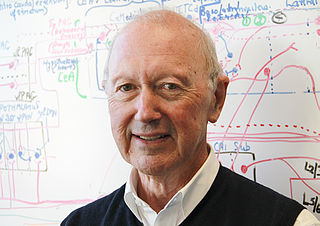Stuart Forbes Macintyre was an Australian historian, and Dean of the Faculty of Arts at the University of Melbourne from 1999 to 2008. He was voted one of Australia's most influential historians.
Monash University Faculty of Law, or Monash Law School, is the law school of Monash University. Founded in 1964, it is based in Melbourne, Victoria and has campuses in Malaysia and Italy. It is consistently ranked as one of the top law schools in Australia and globally, and entry to its Bachelor of Laws (LLB) programme is highly competitive.
Adrienne Elizabeth Clarke is professor emeritus of Botany at the University of Melbourne, where she ran the Plant Cell Biology Research Centre from 1982 to 1999. She is a former chairman of the Commonwealth Scientific and Industrial Research Organisation, former Lieutenant Governor of Victoria (1997–2000) and former Chancellor of La Trobe University (2011–2017).

Geoffrey Burnstock was a neurobiologist and President of the Autonomic Neuroscience Centre of the UCL Medical School. He is best known for coining the term purinergic signalling, which he discovered in the 1970s. He retired in October 2017 at the age of 88.

Peter Gavin Hall was an Australian researcher in probability theory and mathematical statistics. The American Statistical Association described him as one of the most influential and prolific theoretical statisticians in the history of the field. The School of Mathematics and Statistics Building at The University of Melbourne was renamed the Peter Hall building in his honour on 9 December 2016.
Raymond Leslie Martin was an Australian chemistry professor and university administrator. He was Vice-Chancellor of Monash University from 1977 to 1987.
The Sydney School of Architecture, Design and Planning, also known as The University of Sydney School of Architecture, Design and Planning, formerly the Faculty of Architecture, Design and Planning, is a constituent body of the University of Sydney, New South Wales, Australia. The school was established in 1920.

Greer Honeywill is an Australian conceptual artist. Her work covers sculptural conventions, autobiography and critical thinking.

Sir Edward Byrne is a neuroscientist who, as of September 2024, serves as President of King Abdullah University of Science and Technology (KAUST), located in Thuwal, Saudi Arabia. Byrne served as President and Principal of King's College London from August 2014 until January 2021. and was previously President Vice-Chancellor of Monash University.
Marilyn Lee Lake, is an Australian historian known for her work on the effects of the military and war on Australian civil society, the political history of Australian women and Australian racism including the White Australia Policy and the movement for Aboriginal and Torres Strait Islander human rights. She was awarded a personal chair in history at La Trobe University in 1994. She has been elected a Fellow, Australian Academy of the Humanities and a Fellow, Academy of the Social Sciences in Australia.
Michael Cowley FTSE is an Australian physiologist. He is best known for his mapping of the neural circuits involved in metabolism and obesity and diabetes treatment. He is a professor in the Department of Physiology at Monash University in the Faculty of Biomedical and Psychological Sciences. He is also a director of the Australian diabetes drug development company, Verva Inc, and director of the Monash Obesity & Diabetes Institute] (modi).
Gilah Chaja Leder is an adjunct professor at Monash University and a professor emerita at La Trobe University. Her research interests are in mathematics education, gender, affect, and exceptionality. Leder was the 2009 recipient of the Felix Klein Medal.

Andrew Justin Stewart Coats is an Australian–British academic cardiologist who has particular interest in the management of heart failure. His research suggested exercise training as a more effective treatment for chronic heart failure. He is known for putting forward the "muscle hypothesis" of heart failure. In addition to this, Coats is a fundraiser, university administrator, and inventor. His Imperial College patents have formed the basis of companies specialising in the treatment of cachexia.

Patricia Arlene Vickers-Rich, also known as Patricia Rich, is an Australian Professor of Palaeontology and Palaeobiology, who researches the environmental changes that have impacted Australia and how this shaped the evolution of Australia’s fauna and flora.
Marilyn Bernice Renfree is an Australian zoologist. She completed her PhD at the Australian National University, was a post-doctoral fellow in Tennessee and then Edinburgh before returning to Australia. Since 1991, Renfree has been Professor of Zoology at the University of Melbourne. Her main research interest focuses on reproductive and developmental biology of marsupials.

Maxwell Richard Bennett is an Australian neuroscientist specializing in the function of synapses.
ProfessorJulie Hazel Campbell AO FAA is an Australian vascular biologist specialising in vascular smooth muscle. She is a professional fellow at the Australian Academy of Science and holds two patents for vascular implant material. Campbell made a groundbreaking discovery in the early 1970s, revealing that smooth muscle cells possess various phenotypes that regulate their biology and reaction to disease triggers, such as heart disease. Additionally, she uncovered methods to sustain these cells in a non-disease state. This newfound knowledge significantly advanced the comprehension of atherosclerotic plaque formation and offered valuable insights into potential preventive measures.

Rachelle Buchbinder is an Australian rheumatologist and clinical epidemiologist. Her clinical practice is in conjunction with research involving multidisciplinary projects relating to arthritis and musculoskeletal conditions. She promotes improvement of communication with patients and health literacy in the community.
Peter Bishop Dixon AO FASSA is an Australian economist known for his work in general equilibrium theory and computable general equilibrium models. He has published several books and more than two hundred academic papers on economic modelling and economic policy analysis.
Terence 'Terry' PhillipO'Brien was an Australian botanist who was an expert in the development of wheat, and who was an early pioneer of Australian eco-tourism.







